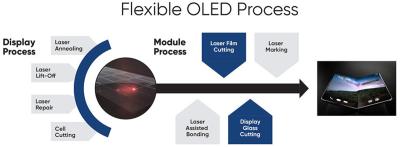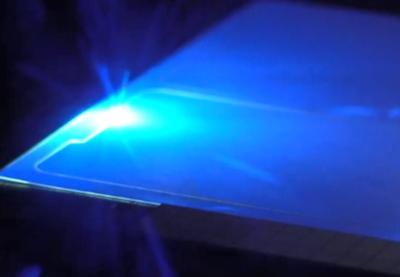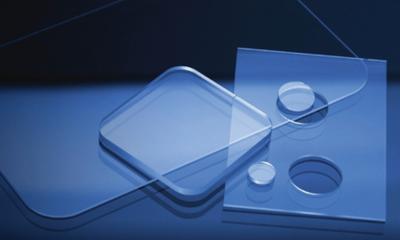The following is a sponsored article by Coherent
It’s well known that laser technology is critical for making OLED displays. In particular, the use of excimer laser annealing (ELA) to transform the amorphous silicon deposited on the display mother glass into polycrystalline silicon is essential for proper device performance.
But lasers are used at many other key steps in the production process. Several of these involve high precision cutting. The figure identifies two of these. The first is FlexOLED shape and hole cutting. The second is coverglass and window cutting.
FlexOLED shape and hole cutting
FlexOLED shape cutting is the process of separating individual displays from their “cell” (which usually contains at least two or three displays) prior to phone or tablet assembly. Additionally, many designs need holes somewhere within the display. These are usually to allow cameras or other sensors to see out. Also, sometimes just some of the display layers are selectively removed over a certain area. This is to accommodate fingerprint sensors that reside under the display but don’t require a through hole.
Shape and hole cutting are extremely demanding for a few reasons. First, they’re being performed on virtually finished displays – with nearly all the cost built into them. You don’t want to scrap a part at this stage!
Also, they need to be accomplished with high mechanical precision. That is, to very tight tolerances and with high repeatability. This is necessary to avoid problems during assembly. Most current cellphones have a display that covers virtually the entire top surface of the device, with a very thin bezel around it. If the display is cut too large, it won’t fit right in the bezel. If it’s too small, gaps will show around the edge. Also, all the holes need to line up properly with whatever goes behind them (cameras, etc.).
FlexOLED shape cutting
Another really critical aspect of these cutting processes is the “heat affected zone” (HAZ) they create. The HAZ is the area next to the edge where heat from the cutting process might affect the display circuitry, or produce bubbles, cracks or other defects. These might be visible to the user’s eye as bad areas in the display. Or, in the case of foldable phones, they can be sources from which cracks might eventually form or propagate.
A maximum HAZ specification for shape cutting a typical phone might be 100 µm. For a foldable display, it could be 50 µm. And, for hole cutting, it’s not uncommon for the maximum allowable HAZ to be under 20 µm.
And, of course, did we forget to mention that the shape cutting processes have to be fast – literally done in just a few seconds maximum? Because cutting has to keep pace with other production steps and meet the extraordinary throughput demands facing mobile device manufacturers.
Ultrashort pulse lasers get FlexOLEDs in shape
There’s only one kind of laser that can cut the mustard – or, more accurately, the display – and meet every single one of these requirements. It’s an ultrashort pulse (USP) laser that operates at high repetition rates, and outputs in the ultraviolet. Let’s unpack why each of those characteristics are so essential.
USP lasers are needed because they deliver a way smaller HAZ than any other laser type – at least the ones that can cut through a display as thick as 0.5 mm in a few seconds. In general, the HAZ gets smaller as the pulses get shorter. So, a femtosecond USP laser can deliver an HAZ of under 10 µm, while a picosecond USP laser can usually get to under 30 µm.
But it’s not quite as clear cut as that. The actual HAZ differences aren’t always as pronounced as the theory might indicate. And there are differences in speed, cost, and other practical considerations that can affect which laser will be “best” for a specific application.
As a result, both picosecond and femtosecond lasers are currently used for production shape and hole cutting. Different phone manufacturers tend to have a “favorite” technology. This is based on HAZ requirements, plus their experience and comfort level with a particular type of laser.
Shape and hole cutting are both performed using a scanner. And the laser must trace out the same path numerous times to cut completely through the display. This makes repetition rate important. It translates directly into cutting speed; if two lasers have the same pulse energy, the one operating at a higher repetition will cut faster.
Finally, UV output is beneficial for a few reasons. First, it’s more equally absorbed than longer wavelengths by all the various materials in the heterogenous stack that makes a display. This means each layer is cut consistently, regardless of its composition.
UV light can also be focused to smaller spot sizes than longer wavelengths (due to diffraction). This increases the energy density of the focused spot, which means that each pulse removes more material. This speeds up cutting. Also, UV light allows the optics to work with a larger depth-of-focus. This makes the cutting process more tolerant of slight variations in part height or thickness.
Coherent supplies both picosecond and femtosecond technologies for FlexOLED shape and whole cutting, so we can help manufacturers choose the right option for their production without any bias. Learn more about our Monaco femtosecond and HyperRapid NXT picosecond lasers
Coverglass and window cutting
Another key production step for phones and other mobile devices is placing a coverglass over the display, and also mounting protective windows over the camera lenses. For cost-effective production, these components must all be rapidly cut out from larger pieces to final shape with high mechanical precision.
The surface roughness and residual stress created by this cutting are important because these affect the break resistance of the final part. Debris creation is also a factor since this may require extra cleaning steps to remove. Another imperative is to avoid damage to any coatings or other functional layers on the components during cutting.
Ultrashort Pulse (USP) laser cutting based on filamentation satisfies all these requirements. But the specific way that this is implemented depends on the process specifics and production economics. Key factors include the window material and thickness, cut length and shape, and the necessary throughput speed.
USP lasers have glass cutting covered
Most of the coverglass used in mobile devices today is chemically strengthened alkali-aluminosilicate, thermally strengthened soda lime glass, or materials similar to these. Coverglass thickness for flexible displays is typically hundreds of microns. It can be as thin as 30 µm for foldable displays.
Coverglass cutting
To decide how to apply filamentation cutting on parts like these, the first consideration is laser repetition rate. This is because in filamentation cutting, the laser beam is moved over the part surface and each pulse (or pulse burst) produces a single filament – a structure that goes all the way through the glass. The goal is to make a series of essentially evenly spaced perforations in the glass (typically spaced about 50 µm apart). Subsequently, stress is induced at the perforation to transform it into a continuous crack. This will allow the part to be separated. Often, this process uses a Coherent CO2 laser to generate very localized heat stress along the perforation line.
The higher the laser repetition rate, the faster the beam can be moved over the glass surface to make holes at a specific spacing. So, for cutting large parts like display coverglass, the Coherent HyperRapid NXT (repetition rate up to 400 kHz) can work over three times faster than the Rapid LX (repetition rate up to 90 kHz), even though both of these lasers deliver the same energy per pulse. But the HyperRapid NXT is larger and more expensive than the Rapid LX.
So, if throughput speed is critical, the HyperRapid NXT is the first choice. But there are situations in which the throughput or overall process is limited by stage motion or beam steering. If these make it so that the laser can’t operate at its highest repetition rate, then the HyperRapid NXT can’t deliver its full benefits. In these instances, it’s possible that the Rapid LX can exactly the same quality cuts and throughput.
Sapphire cutting
Small round sapphire windows are used to cover the camera lenses in most cell phones. Sapphire is extremely hard and scratch resistant. It’s also expensive, which is why it’s used so sparingly.
The filamentation process cuts sapphire with no difficulty. But, because the pieces are physically small and round, the Rapid LX – with its lower repetition rate and lower cost – is usually the best choice. To understand why, you need to know something else about how filamentation is actually performed.
For this technique to work, the laser beam must enter essentially perpendicular to the part surface. Because of this, the focusing optics are typically fixed and the work piece moved with stages. Scanners aren’t used because they would cause the beam to come in at an angle to the surface at some parts of the cut.
Quickly cutting the small circular sapphire windows means that these motors must continually accelerate and decelerate. And the smaller the part, the higher this acceleration gets. Of course, there’s a limit to the acceleration these motors can produce. Generally, they can’t go fast enough to keep up with a laser operating at 400 kHz and produce the desired filament spacing. This means the laser would have to operated at a lower repetition rate. This makes the Rapid LX the optimum choice.
Coherent is focused on cut quality
The beam delivery optics used for filamentation cutting are just as important as the laser source itself. Coherent has developed our own series of focusing optics that are each designed to produce optimum results in different applications.
For example, our “standard” SmartCleave Advanced focusing optics are designed to work with substrates of up to 1.8 mm in thickness. This covers most display applications. But we also have a lens (SmartCleave Advanced LongFi) in which the beam profile has been optimized specifically to enable cutting parts of up to 3 mm in thickness. This will produce different cutting characteristics that are dependent on exact part thickness, so it’s important to understand the tradeoffs involved.
At the other end of the spectrum, we have optics especially for cutting the ultrathin (< 1 mm) glass that is essential to foldable displays. The SmartCleave Advanced Low Damage optics are designed to reduce peak power density within the focus region. This sacrifices the ability to make longer filaments but produces a smaller heat affected zone and a smoother texture on the entrance side. Minimizing this surface roughness is particularly important for ultrathin glass because it directly impacts bend strength.
It's easy to look at a USP laser manufacturer’s datasheet and simply think that higher power will give faster or better results. But that’s not the case at all. And, even once the best laser is chosen, it must still be focused onto the part in just the right way. Rely on a vendor with years of experience in laser glass cutting and hundreds of actual installations to get the recipe for glass cutting right.
Discover all the Coherent USP lasers.





